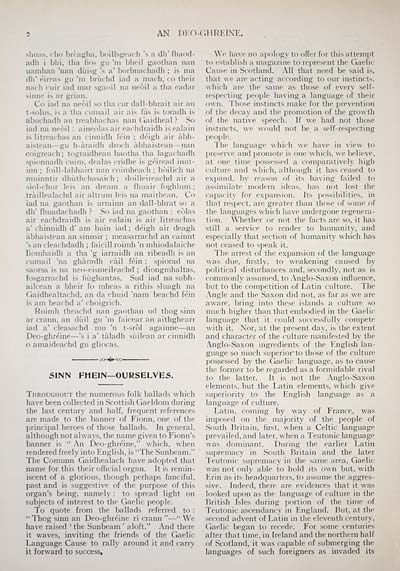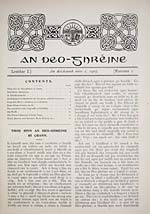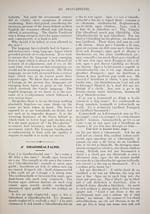Blair Collection > Deo-gréine
(14)
Download files
Complete book:
Individual page:
Thumbnail gallery: Grid view | List view

AN DEO-GHREINE.
shuas, cho brèagha, boillsgeach 's a dh' fhaod-
adh i bin, ilia fios gu 'm bheil gaothan nan
uamhan "nan dùisg !s a' borbnachadh ; is ma
dh* èireas gu 'm brùchd iad a mach, co their
nach cuir iad mar sgaoil na neòil a tlia eadar
sinne is ar grian.
C<> iad na 1 1 1 - «' . i 1 so tha cur dall-bhrait air an
t-solus. is a tha cumail air ais fas is toradh is
abuchadh an treabhachas nan Gaidheal ? So
iad na neòil : aineolas air eachdraidh isealain
is litreachas an cinnidh fèin ; dèigh air àbh-
aistean — gu h-àraidh droch àbhaistean— nan
coigreach; tograidhean baotha tha lagachadh
spionnadh cuim, dealas cridhe is gèiread innt-
inn : foill-labhairt nan coimheach : bòilich na
muinntir dhùthchasaich ; doilleireachd air a
siol-chur leis an dream a fliuair foghlum ;
tràillealachd air altrum leis na maithean. Co
iad na gaothan is nrrainn an dall-bhrat so a
dh' fhuadachadh ? So iad na gaothan : eòlas
air eachdraidh is air ealain is air litreachas
a" chinnidh d' am bum iad ; dèigh air deagh
àbhaistean an sinnsir ; measarrachd an cainnt
"s an cleachdadh ; faicill roimh 'n mhiodalaiche
liomhaidh a tha 'g iarraidh an ribeadh is an
cumail "na ghàradh càil fèin ; spiorad na
saorsa is na neo-eismeileachd ; diongmhaltas,
fosgarrachd is fiughantas. Sud iad na subh-
ailcean a bheir fo mheas a rithis sluagh na
Gaidhealtachd, an da chuid "nam beachd fein
is am beachd a' choigrich.
Roimh theachd nan gaothan ud thog sinn
ar crann. an dùil gu 'in faicear an aithghearr
iad a' cleasachd mu 'n t-sròl againne — an
Deo-ghreine — 's i a' tàladh sùilean ar cinnidh
o amaideachd gu gliocas.
SINN FHE1N— OURSELVES.
Throughout the numerous folk ballads which
have been collected in Scottish Gaeldom during
the last century and half, frequent references
are made to the banner of Fionn, one of the
principal heroes of those ballads. In general,
although not always, the name given to Fionn's
banner is "An Deo-ghrèine," which, when
rendered freely into English, is "The Sunbeam."
The Comunn Gaidhealach have adopted that
name for this their official organ. It is remin-
iscent of a glorious, though perhaps fanciful,
past and is suggestive of the purpose of this
organ's being, namely : to spread light on
subjects of interest to the Gaelic people.
To quote from the ballads referred to :
" Thog sinn an Deo-ghreine ri crann " — "We
have raised 'the Sunbeam' aloft." And there
it waves, inviting the friends of the Gaelic
Language Cause to rally around it and carry
it forward to success.
We have no apology to offer lor this attempt
to establish a magazine to represent the Gaelic
Cause in Scotland. All that need be said is,
that we are acting according to our instincts,
which are the same" as those of every self-
respecting people having a language of their
own. Those instincts make for the prevention
of the decay ami the promotion of the growth
of the native speech. If we had not those
instincts, we would not be a self-respecting
pe< tple.
The language which we have in view to
preserve and promote is one which, we believe,
at one time possessed a comparatively high
culture and which, although it has ceased to
expand, by reason of its having failed to
assimilate modern ideas, has not lost the
capacity for expansion. Its possibilities, in
that respect, are greater than those of some of
the languages which have undergone regenera-
tion. Whether or not the facts are so, it has
still a service to render to humanity, and
especially that section of humanity which has
not ceased to speak it.
The arrest of the expansion of the language
was due, firstly, to weakening caused by
political disturbances and, secondly, not as is
commonly assumed, to Anglo-Saxon influence,
but to the competition of Latin culture. The
Angle and the Saxon did not, as far as we are
aware, bring into these islands a culture so
much higher than that embodied in the Gaelic
language that it could successfully compete
with it. Xor, at the present day, is the extent
and character of the culture manifested by the
Anglo-Saxon ingredients of the English lan-
guage so much superior to those of the culture
possessed by the Gaelic language, as to cause
the former to be regarded as a formidable rival
to the latter. It is not the Anglo-Saxon
elements, but the Latin elements, which give
superiority to the English language as a
language of culture.
Latin, coming by way of France, was
imposed on the majority of the people of
South Britain, first, when a Celtic language
prevailed, and later, when a Teutonic language
was dominant. Dming the earlier Latin
supremacy in South Britain and the later
Teutonic supremacy in the same area, Gaelic
was not only able to hold its own but, with
Erin as its headquarters, to assume the aggres-
sive. Indeed, there are evidences that it was
looked upon as the language of culture in the
British Isles during portion of the time of
Teutonic ascendancy in England. Hut, at the
second advent of Latin in the eleventh century,
Gaelic began to recede. For some centuries
after that time, in Ireland and the northern half
of Scotland, it was capable of submerging the
languages of such foreigners as invaded its
shuas, cho brèagha, boillsgeach 's a dh' fhaod-
adh i bin, ilia fios gu 'm bheil gaothan nan
uamhan "nan dùisg !s a' borbnachadh ; is ma
dh* èireas gu 'm brùchd iad a mach, co their
nach cuir iad mar sgaoil na neòil a tlia eadar
sinne is ar grian.
C<> iad na 1 1 1 - «' . i 1 so tha cur dall-bhrait air an
t-solus. is a tha cumail air ais fas is toradh is
abuchadh an treabhachas nan Gaidheal ? So
iad na neòil : aineolas air eachdraidh isealain
is litreachas an cinnidh fèin ; dèigh air àbh-
aistean — gu h-àraidh droch àbhaistean— nan
coigreach; tograidhean baotha tha lagachadh
spionnadh cuim, dealas cridhe is gèiread innt-
inn : foill-labhairt nan coimheach : bòilich na
muinntir dhùthchasaich ; doilleireachd air a
siol-chur leis an dream a fliuair foghlum ;
tràillealachd air altrum leis na maithean. Co
iad na gaothan is nrrainn an dall-bhrat so a
dh' fhuadachadh ? So iad na gaothan : eòlas
air eachdraidh is air ealain is air litreachas
a" chinnidh d' am bum iad ; dèigh air deagh
àbhaistean an sinnsir ; measarrachd an cainnt
"s an cleachdadh ; faicill roimh 'n mhiodalaiche
liomhaidh a tha 'g iarraidh an ribeadh is an
cumail "na ghàradh càil fèin ; spiorad na
saorsa is na neo-eismeileachd ; diongmhaltas,
fosgarrachd is fiughantas. Sud iad na subh-
ailcean a bheir fo mheas a rithis sluagh na
Gaidhealtachd, an da chuid "nam beachd fein
is am beachd a' choigrich.
Roimh theachd nan gaothan ud thog sinn
ar crann. an dùil gu 'in faicear an aithghearr
iad a' cleasachd mu 'n t-sròl againne — an
Deo-ghreine — 's i a' tàladh sùilean ar cinnidh
o amaideachd gu gliocas.
SINN FHE1N— OURSELVES.
Throughout the numerous folk ballads which
have been collected in Scottish Gaeldom during
the last century and half, frequent references
are made to the banner of Fionn, one of the
principal heroes of those ballads. In general,
although not always, the name given to Fionn's
banner is "An Deo-ghrèine," which, when
rendered freely into English, is "The Sunbeam."
The Comunn Gaidhealach have adopted that
name for this their official organ. It is remin-
iscent of a glorious, though perhaps fanciful,
past and is suggestive of the purpose of this
organ's being, namely : to spread light on
subjects of interest to the Gaelic people.
To quote from the ballads referred to :
" Thog sinn an Deo-ghreine ri crann " — "We
have raised 'the Sunbeam' aloft." And there
it waves, inviting the friends of the Gaelic
Language Cause to rally around it and carry
it forward to success.
We have no apology to offer lor this attempt
to establish a magazine to represent the Gaelic
Cause in Scotland. All that need be said is,
that we are acting according to our instincts,
which are the same" as those of every self-
respecting people having a language of their
own. Those instincts make for the prevention
of the decay ami the promotion of the growth
of the native speech. If we had not those
instincts, we would not be a self-respecting
pe< tple.
The language which we have in view to
preserve and promote is one which, we believe,
at one time possessed a comparatively high
culture and which, although it has ceased to
expand, by reason of its having failed to
assimilate modern ideas, has not lost the
capacity for expansion. Its possibilities, in
that respect, are greater than those of some of
the languages which have undergone regenera-
tion. Whether or not the facts are so, it has
still a service to render to humanity, and
especially that section of humanity which has
not ceased to speak it.
The arrest of the expansion of the language
was due, firstly, to weakening caused by
political disturbances and, secondly, not as is
commonly assumed, to Anglo-Saxon influence,
but to the competition of Latin culture. The
Angle and the Saxon did not, as far as we are
aware, bring into these islands a culture so
much higher than that embodied in the Gaelic
language that it could successfully compete
with it. Xor, at the present day, is the extent
and character of the culture manifested by the
Anglo-Saxon ingredients of the English lan-
guage so much superior to those of the culture
possessed by the Gaelic language, as to cause
the former to be regarded as a formidable rival
to the latter. It is not the Anglo-Saxon
elements, but the Latin elements, which give
superiority to the English language as a
language of culture.
Latin, coming by way of France, was
imposed on the majority of the people of
South Britain, first, when a Celtic language
prevailed, and later, when a Teutonic language
was dominant. Dming the earlier Latin
supremacy in South Britain and the later
Teutonic supremacy in the same area, Gaelic
was not only able to hold its own but, with
Erin as its headquarters, to assume the aggres-
sive. Indeed, there are evidences that it was
looked upon as the language of culture in the
British Isles during portion of the time of
Teutonic ascendancy in England. Hut, at the
second advent of Latin in the eleventh century,
Gaelic began to recede. For some centuries
after that time, in Ireland and the northern half
of Scotland, it was capable of submerging the
languages of such foreigners as invaded its
Set display mode to: Large image | Transcription
Images and transcriptions on this page, including medium image downloads, may be used under the Creative Commons Attribution 4.0 International Licence unless otherwise stated. ![]()
| Early Gaelic Book Collections > Blair Collection > Deo-gréine > (14) |
|---|
| Permanent URL | https://digital.nls.uk/76697847 |
|---|
| Description | A selection of books from a collection of more than 500 titles, mostly on religious and literary topics. Also includes some material dealing with other Celtic languages and societies. Collection created towards the end of the 19th century by Lady Evelyn Stewart Murray. |
|---|
| Description | Selected items from five 'Special and Named Printed Collections'. Includes books in Gaelic and other Celtic languages, works about the Gaels, their languages, literature, culture and history. |
|---|

